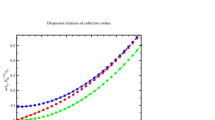Abstract
The hydrodynamic regime of superfluids is dominated by a Goldstone mode corresponding to a spontaneously brokenU(1) symmetry. In this article we map the Kawasaki-Ising model for a classical lattice gas into a quantum model for a superfluid and establish a connection between the normal density fluctuations of the first and the Goldstone mode of the second. The fact that the quantum model we obtain describes a superfluid derives from an inequality by Penrose and Onsager which gives a lower bound to the Bose-Einstein condensate density. Mathematically, the Goldstone mode can be described by means of a “quantum” extension of the local algebra of the Ising model. The classification of its irreducible representations requires an additionalU(1) phase factor and the correspondingU(1) gauge symmetry is spontaneously broken for all finite values of the temperature and of the density.
Similar content being viewed by others
References
H. Spohn,Large Scale Dynamics of Interacting Particles (Springer-Verlag, Berlin, 1991).
A. De Masi and E. Presutti,Mathematical Methods for Hydrodynamic Limits (Springer-Verlag, Berlin, 1991).
S. L. Lu and H. T. Yau, Spectral gap and logarithmic Sobolev inequality of Kawasaki and Glauber dynamics, preprint (1993).
O. Penrose and L. Onsager, On the quantum mechanics of helium II,Phys. Rev. 104:576 (1956).
L. Reatto, Bose-Einstein condensation for a class of wavefunctions,Phys. Rev. 183:334 (1969).
D. Ruelle, Classical statistical mechanics of a system of particles,Helv. Phys. Acta 36:183 (1963).
K. Symanzik, Euclidean proof of the Goldstone Theorem,Commun. Math. Phys. 6:228 (1967).
C. Albanese and M. Isopi, Long time asymptotics of infinite particle systems, preprint (1994).
R. P. Feynman,Phys. Rev. 91:1291 (1953).
K. Binder,Monte Carlo Methods in Statistical Physics, (Berlin, Springer, 1979).
P. W. Anderson,Basic Notions of Condensed Matter Physics (Benjamin-Cummings, London, 1984).
D. J. Amit,Field Theory, the Renormalization Group and Critical Phenomena (McGraw-Hill, 1978).
O. A. McBrian and T. Spencer,Commun. Math. Phys. 53:299 (1977).
D. Forster,Hydrodynamic Fluctuations, Broken Symmetry, and Correlation Functions (Benjamin, New York, 1975).
P. Nozières and D. Pines,The Theory of Quantum Liquids, Vol. 2 (Benjamin, New York, 1966–1990).
J. Feldman, J. Magnen, V. Rivasseau, and E. Trubowitz,Helv. Phys. Acta 66 (1993).
J. Goldstone,Nuovo Cimento 19:154 (1961).
G. Parisi and N. Sourlas,Nucl. Phys. B 206:321 (1982).
J. R. Schrieffer,Theory of Superconductivity (Benjamin, New York, 1964).
Author information
Authors and Affiliations
Rights and permissions
About this article
Cite this article
Albanese, C. A goldstone mode in the Kawasaki-Ising model. J Stat Phys 77, 77–87 (1994). https://doi.org/10.1007/BF02186833
Received:
Accepted:
Issue Date:
DOI: https://doi.org/10.1007/BF02186833



